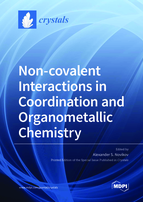Non-covalent Interactions in Coordination and Organometallic Chemistry
A special issue of Crystals (ISSN 2073-4352). This special issue belongs to the section "Organic Crystalline Materials".
Deadline for manuscript submissions: closed (1 April 2021) | Viewed by 14211
Special Issue Editor
Interests: quantum and computational chemistry; computer modeling; non-covalent interactions; reaction mechanisms; catalysis; coordination and organometallic chemistry; supramolecular chemistry
Special Issues, Collections and Topics in MDPI journals
Special Issue Information
Dear Colleagues,
Non-covalent interactions in coordination and organometallic compounds (hydrogen, halogen, chalcogen, pnictogen, tetrel, and semi-coordination bonds; agosic and anagosic interactions; stacking, anion-/cation-π interactions; metallophilic interactions, etc.) are topical in modern chemistry, materials science, crystal engineering, and related fields of knowledge. Both experimental and theoretical methods are widely used for the investigation of the nature and various properties of such weak contacts in gas, liquid, and solid states. Non-covalent interactions could be the driving force to design smart materials with valuable redox, electronic, mechanical, magnetic, and optical properties, promising for the manufacture of LEDs, photovoltaic cells of solar power plants, porous structures, sensors, battery cells, and liquid crystals.
Researchers in various fields of chemistry and other disciplines (physics, crystallography, computer science, etc.) are welcome to submit their work on this topic to our Special Issue “Non-Covalent Interactions in Coordination and Organometallic Chemistry”.
This Special Issue will highlight and overview modern trends and bring various types of non-covalent interactions in coordination and organometallic compounds to the attention of the scientific community.
All types of papers (reviews, mini-reviews, full papers, communications, and technical notes, highlights) are welcome for consideration.
Dr. Alexander S. Novikov
Guest Editor
Manuscript Submission Information
Manuscripts should be submitted online at www.mdpi.com by registering and logging in to this website. Once you are registered, click here to go to the submission form. Manuscripts can be submitted until the deadline. All submissions that pass pre-check are peer-reviewed. Accepted papers will be published continuously in the journal (as soon as accepted) and will be listed together on the special issue website. Research articles, review articles as well as short communications are invited. For planned papers, a title and short abstract (about 100 words) can be sent to the Editorial Office for announcement on this website.
Submitted manuscripts should not have been published previously, nor be under consideration for publication elsewhere (except conference proceedings papers). All manuscripts are thoroughly refereed through a single-blind peer-review process. A guide for authors and other relevant information for submission of manuscripts is available on the Instructions for Authors page. Crystals is an international peer-reviewed open access monthly journal published by MDPI.
Please visit the Instructions for Authors page before submitting a manuscript. The Article Processing Charge (APC) for publication in this open access journal is 2600 CHF (Swiss Francs). Submitted papers should be well formatted and use good English. Authors may use MDPI's English editing service prior to publication or during author revisions.
Keywords
- Non-covalent interactions
- Crystal engineering
- Organometallic compounds
- Coordination compounds
- Crystalline materials
- Supramolecular systems






